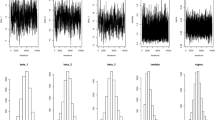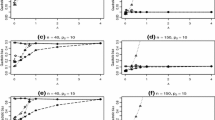Abstract
This paper considers the shrinkage estimation of multilevel models that are appropriate for ordinal longitudinal data. These models can accommodate multiple random effects and, additionally, allow for a general form of model covariates that are related to the overall level of the responses and changes to the response over time. The likelihood inference for multilevel models is computationally burdensome due to intractable integrals. A maximum marginal likelihood (MML) method with Fisher’s scoring procedure is therefore followed to estimate the random and fixed effects parameters. In real life data, researchers may have collected many covariates for the response. Some of these covariates may satisfy certain constraints which can be used to produce a restricted estimate from the unrestricted likelihood function. The unrestricted and restricted MMLs can then be combined optimally to form the pretest and shrinkage estimators. Asymptotic properties of these estimators including biases and risks will be discussed. A simulation study is conducted to assess the performance of the estimators with respect to the unrestricted MML estimator. Finally, the relevance of the proposed estimators will be illustrated with a real data set.




Similar content being viewed by others
References
Agresti, A. (2010). Analysis of Ordinal Categorical Data. Hoboken, New Jersey: Wiley.
Ahmed, S. E., Doksum, K., Hossain, S., & You, J. (2007). Shrinkage, pretest and LASSO estimators in partially linear models. Australian and New Zealand Journal of Statistics, 49(4), 461–471.
Albert, P. S., Hunsberger, S. A., & Biro, F. M. (1997). Modeling repeated measures with monotonic ordinal responses and misclassification, with applications to studying maturation. Journal of the American Statistical Association, 92, 1304–1211.
Bellamy, N., Buchanan, W. W., Goldsmith, C. H., Campbell, J., & Stitt, L. (1988). Validation study of womac: A health status instrument for measuring clinically-important patient-relevant outcomes following total hip or knee arthroplasty in osteoarthritis. Journal of Orthopedics and Rheumatology, 1, 95–108.
Goldstein, H. (2010). Multilevel Statistical Models. Chichester: Wiley.
Hedeker, D., & Gibbons, R. (1994). A random-effects ordinal regression model for multilevel analysis. Biometrics, 50(4), 933–944.
Hedeker, D., & Gibbons, R. D. (2006). Longitudinal data analysis. New York: Wiley.
Hossain, S., Ahmed, S. E., & Doksum, K. A. (2015). Shrinkage, pretest, and penalty estimators in generalized linear models. Statistical Methodology, 24, 52–68.
Hossain, S., Ahmed, S. E., Yi, Y., & Chen, B. (2016). Shrinkage and pretest estimators for longitudinal data analysis under partially linear models. Jounal of Nonparametric Statistics, 28(3), 531–549.
Hox, J., Moerbeek, M., & van de Schoot, R. (2018). Multilevel Analysis: Techniques and Applications, Third Edition (Quantitative Methodology Series). New York: Routledge.
Hox, J. J., Moerbeek, M., & Schoot, R. (2017). Multilevel analysis: Techniques and applications. New York: Routledge.
Lee, K., & Daniels, M. J. (2008). Marginalized models for longitudinal ordinal data with application to quality of life studies. Statistics in Medicine, 27(21), 4359–4380.
Lee, Y., & Nelder, J. A. (2004). Conditional and marginal models: Another view. Statistical Science, 19(2), 219–238.
Lian, H. (2012). Shrinkage estimation for identification of linear components in additive models. Statistics and Probability Letters, 82, 225–231.
Liu, Q., & Pierce, D. A. (1994). A note on gauss-hermite quadrature. Biometrika, 81(3), 624–629.
Magnus, J. R. (1988). Linear Structures. Oxford, London: Charles Griffin.
Raudenbush, S. W., & Bryk, A. S. (2002). Hierarchical Linear Models: Applications and data analysis methods. Thousand Oaks: Sage Publications Ltd.
Skrondal, A., & Rabe-Hesketh, S. (2004). Generalized latent variable modeling: Multilevel, longitudinal, and structural equation models. London: Chapman and Hall/CRC.
Snijders, T. A. B., & Bosker, R. J. (2012). Multilevel Analysis: An Introduction to Basic and Advanced Multilevel Modeling. London: SAGE Publications Ltd.
Stroud, A. H., & Sechrest, D. (1966). Gaussian quadrature formulas. Upper Saddle River: Prentice-Hall.
Thomson, T., & Hossain, S. (2018). Efficient shrinkage for generalized linear mixed models under linear restrictions. Sankhya A: The Indian Journal of Statistics, 80, 1–26.
Thomson, T., Hossain, S., & Ghahramani, M. (2016). Efficient estimation for time series following generalized linear models. Australian & New Zealand Journal of Statistics, 58, 493–513.
van der Vaart, A. W. (1998). Asymptotic Statistics. New York: Cambridge University Press.
Wu, C. O., & Chiang, C. T. (2000). Kernel smoothing on varying coefficient models with longitudinal dependent variable. Statistica Sinica, 10, 433–456.
Zeng, T., & Hill, R. C. (2016). Shrinkage estimation in the random parameters logit model. Open Journal of Statistics, 6, 667–674.
Acknowledgements
The OAI is a public–private partnership comprising five contracts (N01-AR-2-2258; N01-AR-2-2259; N01-AR-2-2260; N01-AR-2-2261; N01-AR-2-2262) funded by the National Institutes of Health, a branch of the Department of Health and Human Services, and conducted by the OAI Study Investigators. Private funding partners include Merck Research Laboratories; Novartis Pharmaceuticals Corporation; GlaxoSmithKline; and Pfizer, Inc. Private sector funding for the OAI is managed by the Foundation for the National Institutes of Health. This manuscript was prepared using an OAI public use data set and does not necessarily reflect the opinions or views of the OAI investigators, the NIH, or the private funding partners. We express our sincere thanks to the editor, associate editor, and the referees for their constructive and valuable suggestions, which led to an improvement of our original version of the manuscript. Shakhawat Hossain and Saumen Mandal were supported by Discovery Grants from the Natural Sciences and the Engineering Research Council of Canada.
Author information
Authors and Affiliations
Corresponding author
Additional information
Publisher’s Note
Springer Nature remains neutral with regard to jurisdictional claims in published maps and institutional affiliations.
Electronic supplementary material
Below is the link to the electronic supplementary material.
Appendix
Appendix
Proof of transforming the prior distribution in (6) of Sect. 3:
Applying the transformation \(\varvec{u} = \varvec{G\psi } + \varvec{\mu },\) where \(\varvec{GG^{\mathsf {T}}}\) = \(\varvec{\Sigma _U}\) and \(D_{ij}\) = \(\varvec{X}_{ij}^{\mathsf {T}} \varvec{\beta } + \varvec{Z}_{ij}^{\mathsf {T}} (\varvec{G\psi } + \varvec{\mu})\):
Thus, denoting \(h(\varvec{\psi })\) as the multivariate standard normal distribution completes the proof.
Proof of equation (7): We begin by writing the full likelihood for the response as:
Taking logs of both sides yields and setting \(f(\varvec{Y}_i) =\int _{\varvec{\psi }}\ell (\varvec{Y}_{i}|\varvec{\beta },\varvec{\psi }) h(\varvec{\psi })d\varvec{\psi }\),
Now, taking the partial derivative with respect to the parameters, we have:
where
Rights and permissions
About this article
Cite this article
Hossain, S., Hiebert, I. & Mandal, S. Estimation strategy of multilevel model for ordinal longitudinal data. Jpn J Stat Data Sci 2, 299–322 (2019). https://doi.org/10.1007/s42081-019-00035-1
Received:
Accepted:
Published:
Issue Date:
DOI: https://doi.org/10.1007/s42081-019-00035-1




